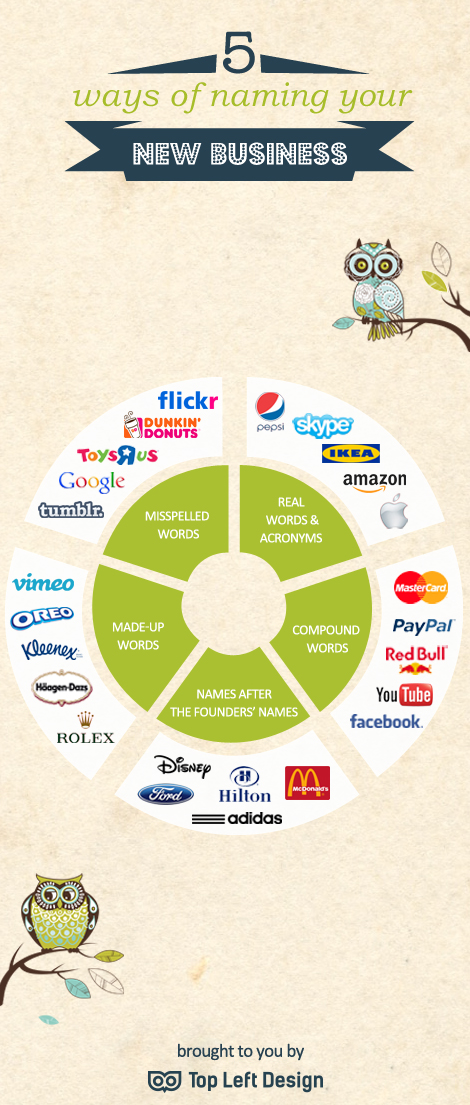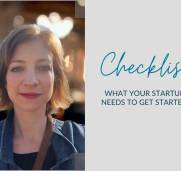7 steps to choosing a name for your company
It’s a big decision and not to be taken lightly. Which is why you can’t just go out and ask people “what should I name my business?” and hope someone will come up with a perfect name. This is why they pay the branding agencies the big bucks! And sometimes, people pay the big bucks and end up coming up with their business name in a “bathroom revelation”.
It happens.
Here are 5 different ways to name your business:
- Mispelled Words (Flickr, Dunkin Donuts)
- Real Words and Acronyms (Ikea and Apple)
- Compound Words (RedBull, Facebook)
- Made Up Words (Vimeo, Oreo, Kleenex, Rolex)
- Names after the founders names (Disney, McDonalds, Ford)

So, here are some steps that I would recommend you take in order to create a shortlist of possibilities.
Step 1: Know yourself
You may not have a business name yet, but even when your business is a seedling of an idea you will need to ask yourself what problems you solve, who your audience is, what’s different about the way you offer your product or service, and what beliefs you want people to have about you. Write all this down – it may evolve but you need to get this down anyway. What is your pricing going to be like? What about positioning? Will you be low cost, mainstream, or premium?
Step 2: Write down the obvious (and boring names)
Even if these names are not right – write down the first most boring or unimaginative options – eg the one where you put the surname of your founding partners/founder into the name of the business (eg: Frinkestein Insurance Services), and where you put adjectives about how you do things next to those (eg: Streamlined Insurance Services). You may use parts of these words so good to have them on hand.
Step 3: Brainstorm words you like
Let yourself be free with this. Brainstorming is just for you. Allow it to be a stream of consciousness. Use words you like, colours, adjectives, weird sounding words, words that match your values. Cross out words you don’t like. It doesn’t matter if some of these ideas are lame. You need to do a brain dump. If you want you can do this with someone else. Just go for it – some of the words may be used in future for branded services/products.
Step 4: Market Research
Take all the people in your industry – the competitors, the partners, the people in the same “food chain” or ecosystem. Group them into different name types – eg “named after people in the company” or “made up words” or “words that show what the company does”. Group them also according to positioning – low cost, premium, mid range – and see who fits where.
You really need in-depth market research when determining a name for your company. There are so many things that you should consider. For example, one aspect of market research to consider on is how a name would sound in other languages. You may need help from a native speaker or translator to translate company names to see how they would sound, especially in the languages of the areas you are targeting.
Step 5: Where does it feel right?
Look at the different groups and ask yourself – where do I fit in? Do you see any patterns that arise? Is there a particular feeling you get – that your business makes sense amongst those with made up names, or those with names after your founder? This can help narrow down the type of name you fit into.
Step 6: Create a long list and then a shortlist
Take the words you got from your brainstorming and combine them with some of the straightforward names. Work in the bits that feel right in terms of the type of name (made-up word, compound word, misspelled word, name of the founder or real word) and where your peers are. If you run a service-based business – feel free to add the words of what you are (eg Truestone Insurance Services, or Frederic & Potts Florists)
Step 7: Survey
Choose 3 or 6 or 10 people you trust, would-be clients, and friends, and ask for their input. Ask people who fit into your target demographic – who have the lifestyles and problems of the people you know would be ideal customers/clients for you. They are really the ones who should be influencing your decision.
This isn’t a final solution – it depends on a lot of things – like the name of your founders, what your business does, and the answers you get in Step 1. But this hopefully gives you some options to shortlist. At the end you may have 2-3 to choose from, and then you can take it out to vote – or go with your gut!
Good luck and let me know what you come up with!


